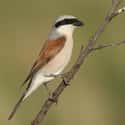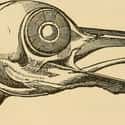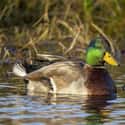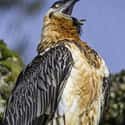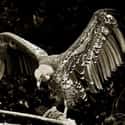-
(#7) Shrikes Impale Their Prey With Thorns
If you were to see a shrike while out and about, you might think they look pretty cute. However, what you are really seeing is a vicious and sadistic little bird. The shrike, upon killing its prey, traditionally uses its curved beak to strike a death blow. But even then the victim's torture is not at an end. After death, the bird takes the body, finds a thorny tree or even barbed wire, and impales its prey onto the spike. Occasionally it even does this while the victim is still alive. Bird watchers may find small lizards and rodents stuck on barbed wire fences or trees while searching for any of the 30 species of shrike.
But why does the shrike do this? For one thing, the bird has sensitive feet, so it cannot hold its prey and sit on a branch at the same time. So the shrike uses said spikes to hold food still for eating and storage. However, shrikes also do this because female shrikes are attracted to all those dead bodies. The more dead bodies a male has on his turf, the more likely he is to get a female. They may even decorate the bodies of their prey with ribbons and shiny objects.
-
(#16) Woodpeckers Have To Store Their Tongues In Their Necks
Everyone knows that woodpeckers sport strong, long beaks that can peck right through tree bark. But these animals have yet another unusual feature: their tongues.
Not only is a woodpecker's tongue often covered with a sticky saliva and barbs, but it is also incredibly long. Some birds can even extend their tongues four inches in length. Because of this unusual size, a woodpecker tongue needs special storage and does not just sit in the mouth, like they do on humans. Instead, the woodpecker tongues curl back into a special compartment in the back of the bird's head between the skull and the skin for storage. Basically, a woodpecker stores his tongue in the back of its neck!
-
(#9) Mallard Ducks Get Physically Violent With Females, So Females Have A Secret Weapon
Ducks, when it comes to mating, are super bizarre. Ducks have some of the biggest male organs for the bird's size, especially considering that the vast majority of bird species don't have them at all. Not only are these organs long, sometimes even longer than the duck's actual body, but they are curled in a spiral and ribbed all over. Mallard ducks have also been known to violently attack females while mating, and mating with unwilling females, even drowning them in efforts to breed.
The female duck's genitalia are strange, too. They are spiraled inside, with some parts ending in dead ends, in an evolutionary attempt to keep more assault-prone males from reproducing with them. Seeing ducks mate is already a bizarre sight, and with all this imagery in mind, it's an even stranger concept.
-
(#12) The Bearded Vulture Lives Almost Entirely Off Of Bones
The bearded vulture has a rather unusual name in other cultures, including "quebrantahuesos." Roughly translated, this name means "bone breaker," and it's pretty much accurate. Not only do these birds bathe in rusty dust to make themselves look fierce, but they are massive: one of the largest vulture species in the world. They have piercing yellow and red eyes and, oh yeah, their entire diet is essentially made up of bones. Rather than eating meat, bearded vultures prefer to seek out skeletal corpses that have already been picked clean, and they will then break the bones into pieces and just eat those pieces whole.
If you ever come across one of these, it's also pretty likely that you'll be able to come find the same bird years down the line. They like to stick to the same basic area to feed, and can live up for 45 years, so some of these birds may outlive you... and end up eyeing your bony remains.
-
(#4) More Than 10% Of Bird Species Are Endangered
Perhaps one of the saddest frightening facts about birds is that they are a dwindling group of animals. In 2016, 13 bird species were declared extinct, and many are still headed in that direction. The IUCN has recognized 742 bird species in recent years, and at least 11% of those species have been found to be threatened or endangered. This has to do with illegal trade, unsustainable agriculture, and even destruction of habitat and invasive species edging them out. There are around 10,000 known species of birds in the world, and well over 1,000 of them are endangered or threatened. That's about 12%, and that number may continue to grow in coming years. So, even if you find a bird creepy or scary, remember that the world would be a much more scary place without them.
-
(#15) Some Vultures Are Impervious To Anthrax
You might just think of vultures as ugly, creepy birds but in reality... okay, they're still really creepy. But their creep factors mask some pretty amazing details. For one thing, they are incredibly resistant to most illnesses, and can eat carcasses infected with terrible diseases that would turn most other animals' stomachs. Some vultures can safely ingest cholera, salmonella, botulism, and even anthrax without getting sick.
One reason they are able to do this has to do with the high level of strong acids in their stomachs. They have a stomach acid around zero pH, and this extreme acid level kills most parasites and bacteria before they are even able to get to a bird's intestines. Couple this with a great immune system and some very special genes, and you've got one strong, garbage disposal of a bird.
New Random Displays Display All By Ranking
About This Tool
Under normal circumstances, most birds are harmless and gentle, such as swans, magpies, and ostriches. They are so cute that people can't help but want to touch them. However, many people overlook some important facts about birds. For example, owls are one of the most terrifying killers, they can turn their heads 270 degrees in any direction and eat the whole prey. Many birds in nature are highly dangerous. Once they are angered, the attack power of these birds is beyond our imagination.
The random tool introduced 18 terrifying facts about birds that most people never know. There are more than 5,000 bird species known in the world, but more than 10% of bird species are endangered. Humans should pay more attention to environmental protection and animal protection to maintain a good ecological balance.
Our data comes from Ranker, If you want to participate in the ranking of items displayed on this page, please click here.











